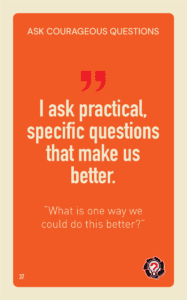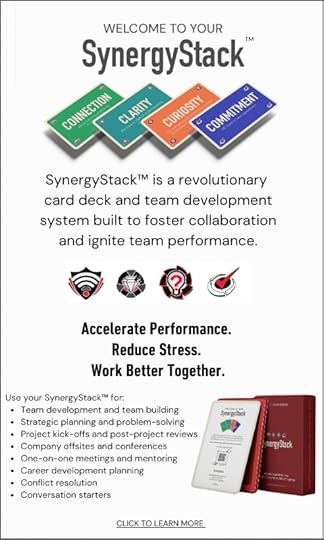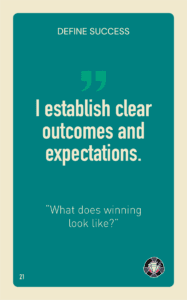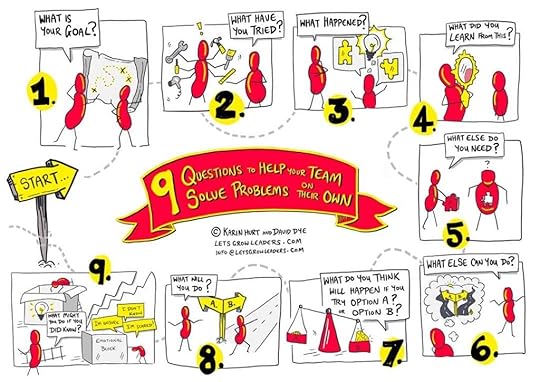David Dye's Blog, page 16
September 20, 2024
Sustainable Leadership: A Blueprint for a Better World
Have you ever wondered how businesses can foster sustainable leadership, creating real, lasting change without sacrificing profitability? What if you could learn the secret formula for making an environmental or social impact while also standing out in your industry?
In this episode, we dive deep into what it takes to create meaningful strategic change that matters in today’s world. Whether you’re leading a team or managing a company, sustainability is a crucial challenge. Learn how the food industry has led the way and how the lessons shared here can help you create a sustainable impact in your field without sacrificing competitive advantage.
You’ll gain insights into:
Defining sustainability in a business context and why it’s essential.Picking the right battles for creating change while maintaining profitability.Leveraging relationship capital to collaborate with advocates and drive results.You Can’t Market Manure at Lunchtime
[00:00] – Defining Sustainability in Leadership
The episode kicks off by exploring what sustainability really means in business. This sets the stage for the rest of the episode as Maisie Gansler breaks down how leadership sustainability should be specific to your industry.
[03:17] – A Seventh-Grade Leader
Maisie shares a personal story from seventh grade, highlighting the moment she realized the importance of leadership. From choosing leadership electives in junior high to becoming a key figure in sustainability, her journey offers a unique take on how early leadership can shape future goals.
[07:09] – What is Leadership Sustainability?
Here, the conversation dives deeper into leadership sustainability—focusing on long-term positive impact, not just short-term gains. The hosts talk about how real leaders create change that can be sustained for generations, whether it’s environmental or social. It’s about making decisions today that others can build upon tomorrow.
[09:46] – The Unappetizing Truth Behind Industrial Agriculture
Maisie shares an eye-opening story about her CEO’s passion for addressing industrial agriculture’s unsustainable practices. This segment showcases the tension between doing the right thing for sustainability and keeping customers engaged. It’s a balancing act of transparency and strategy.
[12:23] – Turning Leadership Sustainability into Competitive Advantage
Maisie emphasizes how leadership sustainability isn’t just a buzzword—it’s a real opportunity to stand out in your industry. When you lead with sustainable practices, it forces your competitors to catch up, creating a ripple effect of positive change.
[15:17] – Raising the Bar with Cage-Free Eggs
Maisie shares a groundbreaking example from 2005 when Bon Appétit became the first company to commit to cage-free eggs nationwide. This decision raised the bar for the industry and made leadership sustainability not just a goal but a competitive advantage.
[19:43] – Tackling Complexity One Step at a Time
Sustainability initiatives aren’t easy, and Maisie doesn’t sugarcoat it. She explains that part of leadership sustainability is embracing the complexities of the issues you tackle, from animal welfare to supply chain challenges. Leaders need to learn as they go.
[25:05] – The Importance of Allies in Advocacy
Maisie talks about how forming partnerships with advocacy groups can help your business build credibility and expertise. These relationships are key to achieving leadership sustainability because they provide industry-specific knowledge and public support.
[33:39] – Managing Your Sustainability Portfolio
Bon Appétit uses a simple system to track progress on sustainability initiatives—red, yellow, and green. Maisie walks listeners through how this tool helps manage ongoing projects and push leadership sustainability forward in a structured way.
[43:40] – Can Middle Managers Drive Leadership Sustainability?
To wrap up, Maisie offers advice for middle managers who want to make an impact. She encourages listeners to start with what they can control and build momentum from there. Leadership sustainability doesn’t have to start at the top—you can lead change from wherever you are.
Connect with Maisie Ganzler:
maisieganzler.comhttps://www.linkedin.com/in/maisie-ganzler/Looking for other ways to develop your team? Check out SynergyStack™.The post Sustainable Leadership: A Blueprint for a Better World appeared first on Let's Grow Leaders.
September 16, 2024
How to Motivate Employees to Have More Urgency
Do you ever mutter, “Will they ever get anything done if I don’t follow up? I’m sick of hovering and I’m sure it feels like I’m micromanaging.” Ironically, the higher your sense of urgency, the more you’ll encounter this problem. The solution? A few consistent communication tools will help you motivate employees to meet those deadlines—without constant oversight.
Why Focusing on Urgency Won’t Solve the ProblemTelling your team to “act with urgency” or “be more committed” won’t help them move any faster.
Why not? Because words like “urgency” or “commitment” mean different things to different people. (On a scale of 1—10, David’s sense of urgency is an 8 while Karin’s sense of urgency is an 11. We can both claim we’re acting with urgency, but Karin will usually be faster.)
And if you want proof that people have different definitions of “urgent,” go ask five people to define the word “soon.” You’ll get five different answers.
Your people see their work differently than you do. Some value speed. Others value quality. Still others focus on impact or process.
Instead of focusing on vague words like “urgent,” you can motivate employees to move faster (and lower your stress) through a few consistent communication habits and removing barriers to speed.
5 Essential Communication Skills to Motivate Employees to Have More UrgencyWhen you want to build a culture where people move at a crisp pace, your first job is to eliminate misunderstanding. You can help everyone get on the same page and quickly deal with conflicting priorities by using these communication tools.
1. Schedule the FinishIf you’re a high-urgency leader and you’re frustrated with your team, this conversation will solve many of your problems.
Stop leaving follow-through to good intentions, will power, or different interpretations of “soon.” Instead, schedule the finish.
Scheduling the finish means you have a conversation about feasibility and competing priorities. The conversation ends with an appointment for follow-through at a specific time, listed on the calendar of everyone involved.
When you schedule the finish, there are two types of tasks that need your focus: routine tasks and delegated assignments.
Schedule the Finish for Routine TasksThese routine tasks can be frustrating. You might think, “This is part of your job—why can’t you just get it done?” If that sounds familiar, try grouping these routine tasks into buckets and setting shared deadlines.
Here’s the key question: with no extra conversation between you and your team, if we asked them, “What does your manager expect in terms of when these tasks should be done?” would they give me the same answer you would?
(Not sure what they’d say? Ask them—their answers might surprise you!)
If everyone agrees about what success looks like, great. But if their answers differ from yours or they seem unsure, it’s time to set clear expectations for each bucket of work.
You can apply the same approach to ongoing tasks, too. The goal might be something like “finish this weekly.” For example, if an employee handles customer contact and needs to document conversations and actions, you could aim for 100% completion by the end of the day every Wednesday and Friday.
Schedule the Finish for Delegated AssignmentsYour team members constantly decide where to put their time. A clear finish line with mutual accountability helps everyone make better decisions.
For example, you have a conversation with one of your team members about following up on a customer complaint. She agrees the customer issue needs investigation.
Before you leave the conversation, you say, “Let’s schedule the finish. Can you and your team investigate what happened, then make suggestions on how we can address it by Friday at 3?”
Your team member mentions another project that’s due that same afternoon. Upon reflection, you decide the customer issue is more important and give her team until Tuesday to complete the first project, so they have time to deal with the customer’s issue.
You conclude the conversation by making an appointment on your calendars for 3 pm Friday, when she will brief you on their findings.
2. Check for UnderstandingThis next communication tool to create a culture of timeliness reduces misunderstandings. Check for understanding means to ensure that everyone in a conversation has the same comprehension of what you agreed.
Checking for understanding is not asking “Do you understand?” Instead, you might say, “Before we wrap up, let’s check for understanding. What are we doing next? What’s our goal here? And when are we meeting to follow up?”
3. 5 x 5 CommunicationAny message that is critical to your team’s success requires consistent communication. 5 x 5 communication means that you communicate critical content at least five times through five different channels.
This repetition and variety ensure that everyone internalizes the message.
5 x 5 communication will help you reinforce not only when things should be done, by more importantly: WHY that timeframe is critical
4. Address Conflicting Values and PrioritiesOne way you can unintentionally frustrate your employees is by creating conflict and expecting them to resolve it. Leaders do this all the time because every value or priority will conflict with another value or priority at some point.
An easy example is the tension between urgency and quality. You can always do something faster – if you are willing to sacrifice quality. How should your employees resolve this tension?
The worst thing you can do is leave them to their own devices and then get upset when they don’t make the decision you would prefer.
Instead, address these conflicts head on. Own them. Talk about them. Have senior leaders tell strategic stories about how you’ve dealt with these conflicts in the past and how you hope your team will resolve them in the future.
5. Close the Loop with Celebration and AccountabilityEarly in my (David’s) career, the CEO asked me to take on a special project. He had a clear finish line, and I worked evenings and through the weekend on top of my regular work to get it done.
When I (quite proudly) brought the finished project to him, he looked confused. I reminded him what he had asked me to do. He laughed and said, “Oh, we’re not doing that anymore. We’re going a different direction.”
Ouch.
You can probably imagine that I didn’t treat his future requests with the same urgency.
This was a pretty awful example of not closing the loop.
Every time you ask something of your team, you create an open loop. You have an intention—and you fulfill that intent. Or you don’t.
Either way, you need to close the loop. If the team did it, celebrate. Acknowledge their work. And if they didn’t do it, have an accountability conversation. See what the team can learn. Can they get it done now? Or learn something to help for the future?
Closing the loop builds momentum. It tells your team that you truly value their follow-through.
Motivate Employees by Removing RoadblocksRoadblock #1—A Missing “Why”Your team needs to understand the reason for their work. What’s the why? A missing why creates roadblocks to urgency because other tasks with well-understood “whys” will take priority.
Use your 5 x 5 communication strategy to answer the questions your team is asking: What business purpose does this urgency serve? How does it improve the customer or employee experience?
Connecting timelines to meaningful reasons “why” will also help you avoid the next roadblock…
Roadblock #2—False Urgency (or Everything’s Urgent)You lose credibility when everything is urgent. Soon, your people tune out your requests. “Oh, everything’s always a last-minute emergency with him. Don’t worry about it.”
As soon as people can’t take you seriously, you’ve become a barrier to timeliness.
Roadblock #3—Risk AversionWe once spoke with a vice president who told us, “I’d rather be late and get it right than early and wrong. I’ll get yelled at for being late, but our President loses his s*** if I make a mistake.”
This President was also frustrated that his team didn’t move quickly enough. He was his own roadblock.
How do you respond to mistakes?
Your people pay attention to your responses.
You might say you don’t want them to spend tons of time building giant decks filled with microscopic columns of data. But if you get angry when they don’t have a specific number at their fingertips, they’ll ignore what you say and pay attention to what you do.
Remove this roadblock by clarifying risk tolerance and celebrating healthy risk—especially when it doesn’t work out.
What is the range of accuracy you expect in their reports or assignments? Clarify acceptable risk up front and treat mistakes as learning opportunities.
Roadblock #4 – Managers Don’t Understand or Aren’t Accountable for Their CommunicationDo you feel like your team has a good sense of urgency, but you struggle to motivate employees throughout your organization to move quickly? If so, this roadblock is certainly part of your problem.
Equip your managers with the five communication skills in this article and hold them accountable for using these tools. When your team consistently schedules the finish, checks for understanding, communicates key messages five times, five different ways, addresses values and priority conflicts, and practices accountability and celebration, you culture will improve.
Urgency at a Human ScalePeople can’t work at speed or with high stress forever. Part of the reason you have a conversation when you schedule the finish is to ensure that workloads are manageable. But even then, a culture of urgency can burnout your best employees and undermine long term success. Here are three suggestions to help you avoid these pitfalls and practice urgency at a human scale.
1. Know Your Race

When you run a 100-meter sprint, you run as fast as you can for the full race (under 10 seconds if you’re a male Olympian sprinter).
But when you run 100-kilometer ultramarathon, you don’t sprint. You don’t run anywhere near as fast. In fact, you might even stop running to eat a snack.
What race are you running? There are times to sprint. And there are times to “run” at a more sustainable pace, take breaks, and rest. Help motivate your employees with a sense of urgency appropriate to the “race” they’re running.
2. Don’t Use Urgency to Address Problems with Process or SystemsIf you have constant “fire drills” or “all-hands-on-deck” scrambles to deal with problems, you’ll burnout your team.
Instead of using urgency to address problems repeatedly, solve the problem. The first time it happens, yes, you need to respond. But now you know it’s an issue. What process or system do you need to fix to prevent it happening again?
Focus on long-term solutions that save urgency for when you really need it. Your team will have energy to respond and trust you when you ask for it.
3. Engage your Team and Ask Them for Their I.D.E.A.sA final way to practice urgency at a human scale is by helping your team to own challenges and solutions.
Do you need to accelerate a project? Create a consistent scheduled finish for routine tasks? Find a faster way to get your customer what they need?
Start by defining the opportunity and why it matters. Then ask your team for their solutions. “Here’s why this is important—how do you think we can do it?”
You can give them the I.D.E.A. model to help them contribute quality suggestions:
I—Why is the idea Interesting and strategically relevant?
D—How is the idea Doable?
E—Who do they need to Engage to make the idea work?
A—What are the specific one or two next Actions to implement the idea?
You’ll get more meaningful ideas. Your team will own the improvements – and often come up with better solutions than you could.
Your TurnWe encourage you to be your own consultant: go ask your team for their understanding of timetables and why critical tasks are done when they are. Explore the gaps. Use the communication skills, remove the roadblocks, and build your culture.
And of course, we love working with organizations like yours to help you infuse these communication skills, motivate employees, and build a culture where people thrive. If we can help, give us a call or write us.
The post How to Motivate Employees to Have More Urgency appeared first on Let's Grow Leaders.
September 14, 2024
How to Have a Successful Global Careeer: Authenticity in Action
How do you build a GLOBAL career and remain AUTHENTIC while leading across countries and contexts? Asking for a Friend.
Today I welcome Serena Aboutboul, Senior Vice President, and head of the Nutrition Strategic Business Unit at Nestlé
 ‘
‘
1. Listen to people (especially consumers).
“We have more commonalities than we think. The challenges, the struggles, the values that you have to apply… they resonate everywhere.
2. Communicate clear, transparent expectations
“And you can’t have clear, transparent communication if it doesn’t speak to your true self. If you are acting, it’s not clear anymore.”
3. Communicating isn’t just about saying what you think or want. It’s about ENGAGING. Listening. Being sure people understand you.
4. The only way to trigger empathy is to show and be yourself– no matter where you are in the world. People notice immediately if you are formatted or are reciting from a text.
5. You also need to consider that country’s culture and norms. It’s not about being yourself no matter what, you need to consider the FRAME.
If you’re in a culture that requires you to act a certain way, do that, because that’s how you demonstrate inclusiveness and that you respect that culture… and by the way it’s fascinating and a constant learning.
6. Be an “AND” person (you know I love that 😉 Serena unpacks that at 2:10 in the countdown timer.
Are you a global leader? Have you led across different countries and contexts? What would you add as #7?
7. _______________
P.S, If you. would like to see how we’ve Nestlè to build a “Care and Dare” Culture, you can watch this short video here. If you’re interested in learning more about
Other articles to help you build an authentic global career.Matrix Organization: Powerful Questions to Reduce Angst and Build Trust
How I Learned the Importance of Being An Authentic Leader
The post How to Have a Successful Global Careeer: Authenticity in Action appeared first on Let's Grow Leaders.
September 13, 2024
Mental Toughness in Leadership: A Guide to Success
Episode 271: Have you ever wondered what sets the best leaders apart from the rest? How do they remain calm under pressure while still achieving extraordinary results? What if the key to success lies in strengthening your mental toughness?
Whether managing a team or striving to become a more resilient leader, mental strength is the cornerstone of your leadership journey. In today’s fast-paced, ever-evolving work environments, the ability to regulate emotions, thoughts, and behaviors is not just a bonus—it’s a necessity. This podcast will help you identify key habits that build mental toughness, enabling you to become a leader who inspires greatness without burning out.
Here’s what you’ll gain by tuning in:
Discover specific, actionable habits to build resilience and grit.Learn how to master self-regulation, especially in high-stress situations.Understand how to cultivate an executive presence that inspires trust and confidence in your team.Mental Toughness for Leadership: Master the Skills You Need[00:22] – Building Habits for Mental Strength
You’ll hear that developing mental strength isn’t about having superhuman resilience—it’s about building habits that train your brain. The key is repetition, and in this episode, you’ll get the exact habits that help leaders develop the mental toughness needed to thrive.
[02:20] – What is Mental Toughness?
Mental toughness is about regulating emotions, thoughts, and behaviors, even in the most challenging circumstances. The episode defines mental toughness as the ability to manage internally so that you can lead externally with confidence and calm.
[04:13] – Early Insights in Leadership
Podcast guest Scott Mautz dives into his journey, sharing how he observed great leaders as early as 30 years ago. He explains how their mental toughness sets them apart, allowing them to lead with clarity even in the face of adversity.
[05:11] – The 6 Mental Muscles of a Strong Leader
Here’s a goldmine: the six mental muscles every leader needs to develop mental toughness—fortitude, confidence, boldness, decisiveness, goal focus, and messaging. Scott breaks them down, giving you a roadmap to strengthen each muscle in your daily leadership practice.
[09:07] – What Mentally Strong Leaders Have in Common
When you think about the best leaders you’ve ever worked with, what do they all share? These leaders know how to regulate their emotions and keep their teams focused, no matter the obstacles.
[13:19] – How Setbacks Build Mental Toughness
Scott uses fascinating Olympic research to explain how setbacks can actually be the secret to developing mental toughness. If you’re a leader facing challenges, this part is a must-listen—it will change how you view failure and growth.
[17:54] – Building Resilience with Daily Habits
You’ll learn that the grind can wear anyone down, but Scott shares practical, everyday habits like gratitude and mindfulness that can help you stay mentally tough. He talks about the power of being present in the moment to ward off burnout and stay focused on what matters.
[31:45] – Confidence and Mental Toughness: The Link
One of the big takeaways is that confidence is directly tied to mental toughness, but it’s not about never feeling doubt. Scott explains how to monitor your relationship with self-doubt and make sure it doesn’t erode your mental strength.
[35:10] – Handling Criticism Like a Mentally Tough Leader
You’ll find out how to handle criticism without letting it tear down your confidence. Scott gives a 3-step process to filter feedback and use it to grow stronger, rather than feeling attacked or defensive.
[45:06] – Creating Your Mental Toughness Action Plan
The episode wraps with a powerful tool: Scott’s Mental Action Plan. It’s all about figuring out which mental muscle you need to work on first, and creating a step-by-step plan to improve your mental toughness over time.
The post Mental Toughness in Leadership: A Guide to Success appeared first on Let's Grow Leaders.
September 7, 2024
Intimidating Questions: How Bad Questions Shut People Down
 Avoid These Intimidating Questions That Can Silence Innovation and Problem Solving
Avoid These Intimidating Questions That Can Silence Innovation and Problem SolvingWhen someone on your team screws up or has one of those “what were they thinking” moments, particularly when the stakes are high. You need to figure out what’s going on– fast. In these moments of stress, it’s tempting to shortcut communication with blunt, intimidating questions to get quick answers.
But here’s the challenge: asking intimidating questions can stifle creativity and problem-solving, leaving your people hesitant to share information, let alone ideas to fix the situation.
Intimidating Questions That Disengage EmployeesThe most dangerous and intimidating questions are those where the asker already “knows” the answer, and just wants the receiver to “get it right.” Closed-ended questions can have a similar impact. It can come across as passive-aggressive to pretend you’re curious when your intent is for your direct report to admit a mistake or agree with you.
Here are a few classic intimidating questions.
What do I have to do to get you to…?Why did you do that?Did I ask you to do that?Is that really working?What is your experience in this area?Who gave you the authority to make that decision?Is that your final decision?Are you sure about that?What makes you think that will work?The Impact of Intimidating QuestionsThink about it—when was the last time you felt energized and motivated after someone asked you, “Why did you do that?” The same is true for your team. They feel criticized rather than supported, and this defensiveness leads to less creativity and more playing it safe. Which is the last thing you need when dealing with complex challenges.
Instead of defaulting to intimidating questions that unintentionally shut a team member down, pause and reframe your approach with empathy.
A simple shift from, “Why did you do that?” to, “Can you walk me through your thought process?” changes the entire tone of the conversation. It signals that you’re genuinely interested in understanding their reasoning, rather than criticizing their actions.
The Power of Asking Better QuestionsSo, what do the right questions look like? They’re questions that help your team think critically, encourage them to explore new ideas, and ultimately guide them toward ownership of the solution. When your team feels safe to share their thoughts, they’re more likely to engage deeply with the problem and come up with innovative solutions.
Here are a few empowering alternatives to common intimidating questions:
Instead of, “What makes you think that will work?” try, “What options have you explored, and what led you to this one?”
Or, Instead of, “Who gave you the authority?” try, “How did you decide this was the right approach?”
Why did you do that?” can become “What were the factors that influenced your decision?”
Or you can try our 9 What’s Coaching Method to help a team member think more critically and solve more problems on their own.
These questions foster a spirit of collaboration. They’re designed to help your team reflect on their thinking, giving them the space to explain their reasoning without feeling attacked. This shift from interrogation to exploration builds trust and encourages problem-solving.
Related Articles:
No More Vague Reports: How to Get Your Team to Give You More Useful Information.
Attention to Detail: How to Help Your Team Have Less “Oops” Moments
Psychological Safety: Why People Don’t Speak Up at Work
Other ways to build stronger, teams who ask better questions of one anotherOf course, your team will be stronger if everyone knows how to turn the intimidating questions into ones that come from a place of genuine curiosity. You can find a list of curiosity habits to make your team stronger.
We’d love to help you and your team accelerate performance, reduce stress, and work better together. Learn about our SynergyStack™ Team Development System and SynergySprint Team Retreats.
The post Intimidating Questions: How Bad Questions Shut People Down appeared first on Let's Grow Leaders.
September 6, 2024
How to Welcome a New Employee: Small Gestures That Show You Care
How do you help a new employee feel welcomed?
I hear from so many employees who tell me how LONELY and DISCOMBOBULATED they felt on their first day. It shouldn’t be that way.
A new employee only gets one first day, and you have one opportunity to make that special. Let’s make it happen.
4 Ways to Make Your New Employee’s Day Special

You might even make a bit of a ruckus. I promise if you watch the first minute of today’s Asking for a Friend with the sound on it will make you smile. One of our clients decorates the office space of every new team member with their name and balloons. Another new employee best practice is to write a handwritten note with specific reasons why you know they will be so valuable to the team and express your confidence in the contribution they are about to make.
The key is to ensure your employee feels seen and cared for. The goal is to have them leave work feeling confident they made the right choice.
Here’s a longer list. Make Your New Hire’s Day: 7 Ways to Improve the New Hire Experience 
You’ve heard this from me before… and it matters so much when you’re building new relationships and new human connections.
Our SynergyStack™ team development deck makes it easy for the new employees to talk about their strengths and learn about the strengths of other team members.
3. Scaffold their first few days with structureThis sounds obvious– but structure creates psychological safety AND it’s often overlooked. I recently had a millennial describe his first day this way. “You know that scene in Seinfeld where George goes to work, sits there all day, does nothing, and goes home? Yeah, my new job is kind of like that.”
That level of frustration is hard to recover from.
4. Ask them for their I.D.E.A.sOur Courageous Cultures research shows that many employees are not asked for their ideas when they first start a new role. This is a PERFECT time to get a fresh perspective.
For more detail on how to do this well check out: How to Capture Best Practices in New Hire Orientation
Your turn. We’d love to hear from you. What are some of your best practices to make a new employee feel welcome. Leave a comment, or join the great conversation that’s happening on Linkedin.
The post How to Welcome a New Employee: Small Gestures That Show You Care appeared first on Let's Grow Leaders.
Boost Productivity with a Human-Centered Culture
Episode 270: In this episode of Leadership Without Losing Your Soul podcast with David Dye, Chris Dyer is joining us to discuss how improving your company culture can also boost productivity. A great place to start? Pinpoint the pillar that’s most lacking in your organization. Is it transparency, positivity, measurement, acknowledgment, uniqueness, listening, or how you handle mistakes? Once you’ve identified the gap, it’s time to take action.
Say transparency is the issue—how can you boost communication and ensure information flows more freely? Or, if listening is the weak spot, think about creating opportunities for open and honest dialogue. Maybe it’s as simple as hosting weekly question sessions or opening up new feedback channels. By focusing on that one key pillar, you’ll start to see real, practical changes in your culture. And trust us, it’s worth it.
Boost Productivity Through Respect and Transparency00:00 – Treat Your People Like Equals
Chris Dyer opens the episode by stressing the importance of treating your people as equals. Talk to your team as if they are at your level, and you’ll be surprised by how much better they perform. This simple shift in communication can instantly boost productivity and team morale.
00:31 – Improving Culture to Boost Productivity and Profits
David Dye introduces Chris Dyer, a culture expert whose companies have been named “Best Place to Work” and “Fastest Growing.” They discuss how building a strong culture doesn’t just make employees happier, but also improves productivity, performance, and profits—a win-win for everyone.
02:09 – Chris’s First Leadership Experience
Chris shares a funny childhood memory of kindergarten, organizing a group to take over the playground. Even back then, he learned a key leadership lesson—getting others to align with your vision can lead to powerful results, a concept that’s essential to boost productivity in any workplace.
04:39 – What is Culture?
Chris breaks down the basics: Culture is how things get done, both seen and unseen. Whether it’s how mistakes are handled or how decisions are made, culture defines the behaviors that drive productivity and success. He emphasizes that improving culture isn’t a vague concept—it’s a science that leaders can apply to boost productivity.
06:33 – The Smallest Unit of Culture
Even in a small team of just five to seven people, culture is already at work. Chris explains that culture can start with just one person, but it’s in groups where it truly forms and impacts results. In any team, the way people communicate and collaborate sets the tone for productivity.
08:40 – The Power of Transparency to Boost Productivity
Chris dives into the first pillar of culture: transparency. When leaders share more information—like company goals and financials—it turns the lights on, allowing employees to contribute better ideas and solutions. This not only builds trust but directly boosts productivity as people feel more connected to the mission.
11:23 – How To Increase Transparency
David and Chris discuss practical ways to increase transparency, like asking teams what information they wish they had or sharing goals openly. When team members know each other’s objectives, it creates alignment and collaboration, which boosts productivity and helps avoid conflicts.
16:57 – Overcoming the Fear of Transparency
Leaders often hesitate to be fully transparent, fearing they’ll look imperfect. Chris counters this by sharing that the best leaders are those who are open, admit mistakes, and show their human side. This honesty creates a culture where teams feel safe to innovate, ultimately boosting productivity.
25:07 – Measurement and Acknowledgement
Chris introduces two more pillars—measurement and acknowledgement. By measuring what matters, whether it’s sales targets or team collaboration, you can focus on the behaviors that drive success. And by acknowledging achievements, you reinforce positive behavior, further boosting productivity.
49:04 – Handling Mistakes to Boost Innovation and Productivity
Mistakes are part of growth. Chris differentiates between errors (due to lack of training or exhaustion) and genuine mistakes (trying something new that doesn’t work out). When leaders celebrate the lessons learned from mistakes, it fosters a culture of innovation, which leads to greater productivity in the long run.
The post Boost Productivity with a Human-Centered Culture appeared first on Let's Grow Leaders.
September 2, 2024
No More Vague Reports: How to Help Your Team Give You Useful Information
Tired of sitting through endless PowerPoint presentations that never answer your question? Does your team drown you with emailed essays and spreadsheets without clear conclusions? Help your team provide more useful information and drive clear decision-making by asking yourself three questions.
Why Your Team Wastes Time with Vague Reports and Frustrating PresentationsWhen your team doesn’t give you the information you need, there are usually a couple of factors at play.
Often, they simply don’t know what you want or how you want it. They don’t understand how you’ll use the information or what happens next.
Sometimes, they’re looking for approval (look at how hard I worked on all this data!). Or they deliver vague reports and drown you in data to keep out of trouble and avoid your anger or criticism.
Three Questions to Help Your Team Give You Useful InformationYou can solve for all these issues and unlock your team’s potential by asking yourself three questions.
1. Have You Clearly Asked for What You Want?

You know what you want. You need a clear recommendation and point of view from the people closest to the issue.
But do your people know that?
If you haven’t clearly asked for what you want, the answer is always “no, they don’t.”
And you almost certainly want that report or analysis differently than their last manager.
When you communicate what you want, think about the following questions:
What will a successful report or presentation do? Are there specific criteria the team needs to meet? Clarify the criteria right away.How will you use the information? If you want raw data to analyze, let them know. If you want a single recommendation with one page of analysis that you can pass to the next level, tell them.How much analysis and precision do you need? Sometimes you need a general direction and a quick summary. Other times, you need maximum confidence and for the team to take the time to make sure it’s right.How do you like to get information? You might prefer to read a report and then ask questions. You might like a verbal presentation.When do you need it? Schedule the finish and ensure they can meet the timetable.Take the time to clarify what you want. Your team can’t meet expectations they don’t know about.
2. Have You Checked for Understanding?Once you tell them what you need, check for understanding. You don’t know that they have it and will truly present useful information until you hear them explain it in their own words. For example, you might say:
“If there aren’t any other questions, let’s do a quick check for understanding. What will a successful report do for us? How and when will you present it?”
Note: asking “Do you understand what you need to do here?” is not a check for understanding. You need to find out what they understand.
3. Are You Responding or Reacting?You asked for what you want. You checked for understanding. But people still bring you vague reports or slide decks with hundreds of irrelevant slides.
Now what?
The next step is to pay attention to how you respond (not react) to your team. If you react poorly, you’ll get more useless information.
We’ve worked with many frustrated senior leaders frustrated who see too many data dumps and endless PowerPoint presentations.
But ask their team what’s going on and they’ll tell you, “It’s a total waste of time. No matter what I present, they’ll tear it apart, tell me I’m an idiot, and go in a different direction. Why waste my time? I don’t need the grief and will just to have redo everything I’d already done.”
When your team doesn’t bring you useful information, of course it’s frustrating. But you can avoid this negative spiral and help them do better next time by choosing a helpful response.
Here are tools to handle the two most common problems:
1. When They Didn’t Do What They AgreedYou asked for a one-page summary with bulleted recommendations you could include in the Board presentation. Due Thursday at 5:00. You checked for understanding and everyone agreed.
But you got a massive PowerPoint presentation with four spreadsheets of data in a microscopic font—on Friday morning.
Your best response here is an accountability conversation. You can use our I.N.S.P.I.R.E. method to have this conversation. Your part of this conversation could look like this:
I – Initiate: “My intent here is to help you prevent rework and for you and the team to be as effective as possible.”
N – Notice: “We agreed that you would present this information in a one-page summary with bulleted recommendations. This isn’t that.”
S – Support: (not really needed here as the problem is self-evident)
P – Probe: “I’m curious what happened?”
I – Invite: “Can you please get the one-page summary we agreed to done today? How can we ensure you do these presentations accurately going forward?”
R – Review: “I’m hearing that you just forgot and scrambled to get it done at the last minute. And that your solution will be to get it in your calendar with the details going forward. Do I have that right?”
E – Enforce: “We have another one of these reports coming up in two weeks. Let’s schedule time on Friday afternoon. I’ve just sent you a calendar invitation. We’ll spend ten minutes to go over that next report and fine-tune it before you submit it.”
2. When You Disagree or Can’t Use Their RecommendationYour team gave you the information exactly as you requested. But just this morning, before their presentation, you got some information that changed the strategy. Now their recommendation doesn’t make sense.
Or maybe, now that you see their data, you disagree with their analysis.
How can you respond in a way that doesn’t discourage, disempower, or deflate?
The answer is to Respond with Regard. There are three steps to respond with regard: gratitude, information, and invitation. You get more of what you celebrate and encourage. So here’s how your part of this conversation might sound:
Gratitude: “Thank you so much for putting this together. I really appreciate the thought you put into it and for caring about where we’re heading.”
Information: “So this morning we learned that the joint venture that would help this project work isn’t going to happen. As I look at your analysis, that understandably played a big role.”
Invitation: “I would love to get your thoughts and recommendation knowing that this partnership isn’t happening. Let’s talk through when we can do that.”
Or, where you see things differently, your information step might sound like:
“Looking at your data, I’m coming to a different conclusion than yours. Here’s what I’m thinking. What am I missing? How do you see it differently?”
Your TurnWhen you consistently ask yourself these three questions, your team won’t just give you useful information. You’ll improve morale, efficiency, and make better decisions. We’d love to hear from you: how do you help your team move from vague reports and data dumps to meaningful information you can use?
You might also like:Managing Up: Turning Information into Influence with Your BossHelp Your Boss Stop Wasting Time with Bad DelegationHow to Get Your Team to Stop Sending You Frustrating Email Communication
The post No More Vague Reports: How to Help Your Team Give You Useful Information appeared first on Let's Grow Leaders.
August 30, 2024
The Change Challenge: Empowering Your Team for Success
Episode 269: In this episode of The Leadership Without Losing Your Soul Podcast, hosted by David Dye, you’ll dive the into change challenge and the fascinating world of behavioral economics with guest Melina Palmer. Behavioral economics is all about understanding how people really make decisions—not always in the logical, rational ways you might expect. By blending economics with psychology, this field gives you powerful insights into why people behave the way they do, which is incredibly useful when you’re leading and driving change.
Imagine you’re leading a team through a major change. Understanding behavioral economics helps you communicate more effectively and really connect with your team. Melina shares practical strategies you can use right away. Reducing cognitive overload on your team, really listening to what they need, and framing your messages in a way that truly resonates. Remember, change can be tough, and your team might feel stressed. But by taking the time to understand and address their concerns, you’ll create a more supportive environment and lead to better outcomes.
Embracing the Change Challenge from the Start00:00 – The episode begins by highlighting how our brains can be tough on themselves when facing a change challenge. Taking the time to truly listen to what someone needs can have a powerful, positive impact on your leadership.
00:22 – David Dye welcomes you to the Leadership Without Losing Your Soul podcast. The podcast is your go-to source for practical tools and strategies to tackle any change challenge without sacrificing your humanity.
00:39 – David introduces Melina Palmer, an expert in behavioral economics. This is a blend of psychology and economics to help you understand and influence decision-making. Both are crucial for navigating any change challenge with your team.
Navigating Behavioral Economics in Leadership01:12 – Melina explains how behavioral economics makes it easier for customers to buy and for employees to buy in, especially during change. By understanding human behavior, you can improve communication and motivation.
03:36 – Melina shares her earliest leadership experience as a child. She naturally took charge during a change challenge on a film set, organizing and guiding people with ease.
06:00 – Next, they discuss how specific words can significantly impact sales and how subtle changes in communication can make a big difference when facing a change challenge. This is something you can apply directly in your leadership.
Mastering the Change Challenge with Behavioral Economics10:01 – Melina also breaks down behavioral economics. A mix of psychology and traditional economics that focuses on how people actually make decisions. This is essential for overcoming any change challenge in your organization.
13:05 – The conversation shifts to why leading through change is a manager’s main job. With up to 35,000 decisions made daily, understanding how the brain handles a change challenge can help you better support your team.
18:02 – They dive into the metaphor of the elephant and the rider, representing the subconscious and conscious brain. Melina discusses how you can guide both to make any change challenge more manageable for your team.
28:01 – Finally, Melina shares a practical story about focusing on what’s most important to your employees. By addressing their real needs during a change challenge, you can significantly improve performance and outcomes.
The post The Change Challenge: Empowering Your Team for Success appeared first on Let's Grow Leaders.
August 26, 2024
Be a Better Coach: 5 Reasons Your Performance Coaching Is Being Ignored
Have you ever had (what you thought was) a great performance coaching conversation—your employee commits to behavior change—but fifteen minutes later they’re back to their old habits?
So you give them more performance coaching, this time “louder” literally or through progressive discipline. But even so, nothing changes.
Most employees don’t come to work hoping to screw up. They want to improve. So why does so much performance coaching not work?
5 Reasons Your Employee Isn’t Acting on Your CoachingWhen we ask employees in our training programs why it’s hard to hear their manager’s feedback, here’s what they tell us.
1. They’re overwhelmed.“I’m trying to do better. But it’s all just too much. Every time we meet, my boss gives me something else to work on. No matter what I do, I can’t get it right. So, I ignore his long list of recommendations and do the best I can.”
What to do instead:
If you want real change, focus on one behavior at a time. Isolate a specific habit to work on and give them the training and support they need. Be sure they master that before moving on to the next development priority.
2. You’re not modeling the way.“My boss keeps telling me my customer courtesy credits are too high—that I’m costing the business too much money. So I stopped giving credits. But when my customers get mad, they escalate to my supervisor. And guess, what? She ALWAYS gives them the credit! She’s the hero, and the credit goes against my numbers and I still end up on progressive action. I can’t win. So now I’m back to giving them the credit.”
What to do instead:
If you want your employees to hear your coaching, follow your standards. Your team will pay closer attention to what you do than what you say.
3. They’re not sure exactly what to do.“My manager says I need to be more strategic. That sounds awesome. I’m all for that. But what does that mean? How do I do that?”
What to do instead:
Be sure your coaching is specific and actionable. Explain what success looks like in terms of behaviors and habits.
See Also: Beyond Magical Thinking: How to Ensure Your Team Gets It
4. They disagree.“My supervisor keeps asking me to enforce a particular policy, but I just don’t think it’s right. It will harm MY customers and I’m sure it’s going to cause them to leave. I’ve tried to explain my concerns, but she tells me to stop thinking so much and just do what I’m told.”
What to do instead:
Explain the “why” behind what you’re asking them to do. Listen to their concerns. If possible look for alternative approaches. If you’ve done what you can to explain why and listened to their concerns, and they still won’t follow the policy, explain the consequences and ask for a commitment.
5. They’re confused.“I’m not sure what’s important, because everything seems to be. I feel like I’m being pulled in a million directions.”
What to do instead:
Help your employees sort through the noise and competing priorities.
Be sure they know what matters most and why.
Most importantly, stay curious.If your performance coaching is not yielding results, get curious and involve them in finding solutions. An I.N.S.P.I.R.E. conversation works well here.
Connect to your intention for the conversation and to the employee at a human level. Notice the behavior that’s not changing. Then show up curious about what’s going on and their ideas for solving your concern.
“I’ve noticed, that even though we’ve talked about this before, you’re continuing to ______ (insert behavior here.) I care about you and want you to be successful. I’m curious how this looks from your perspective. Why do you think this is still happening?” Be curious, and invite them to come up with solutions. Then move the conversation to commitment by scheduling time to talk about how their solution is working.
See Also: How to Provide More Meaningful Performance Feedback.
The post Be a Better Coach: 5 Reasons Your Performance Coaching Is Being Ignored appeared first on Let's Grow Leaders.










